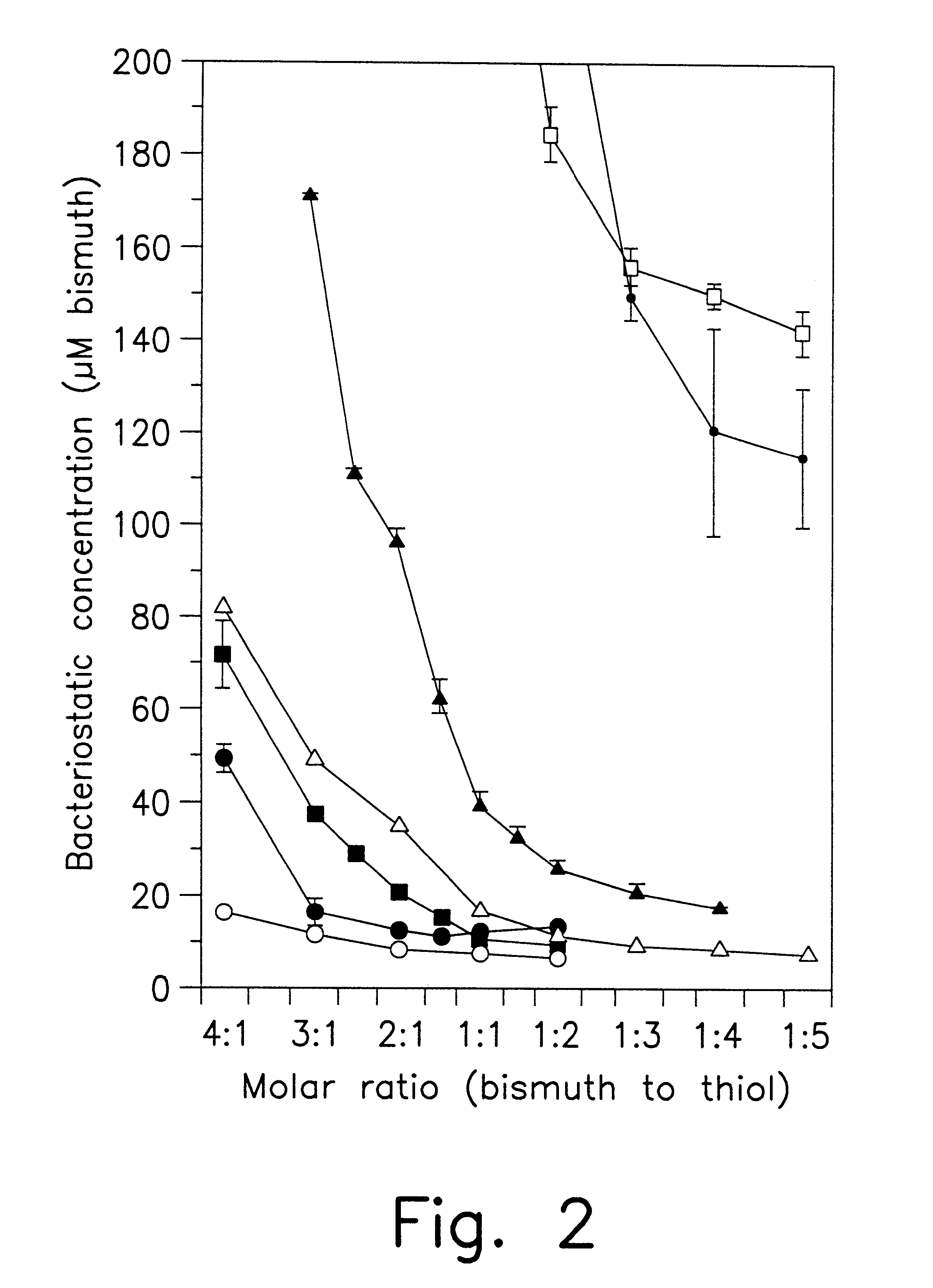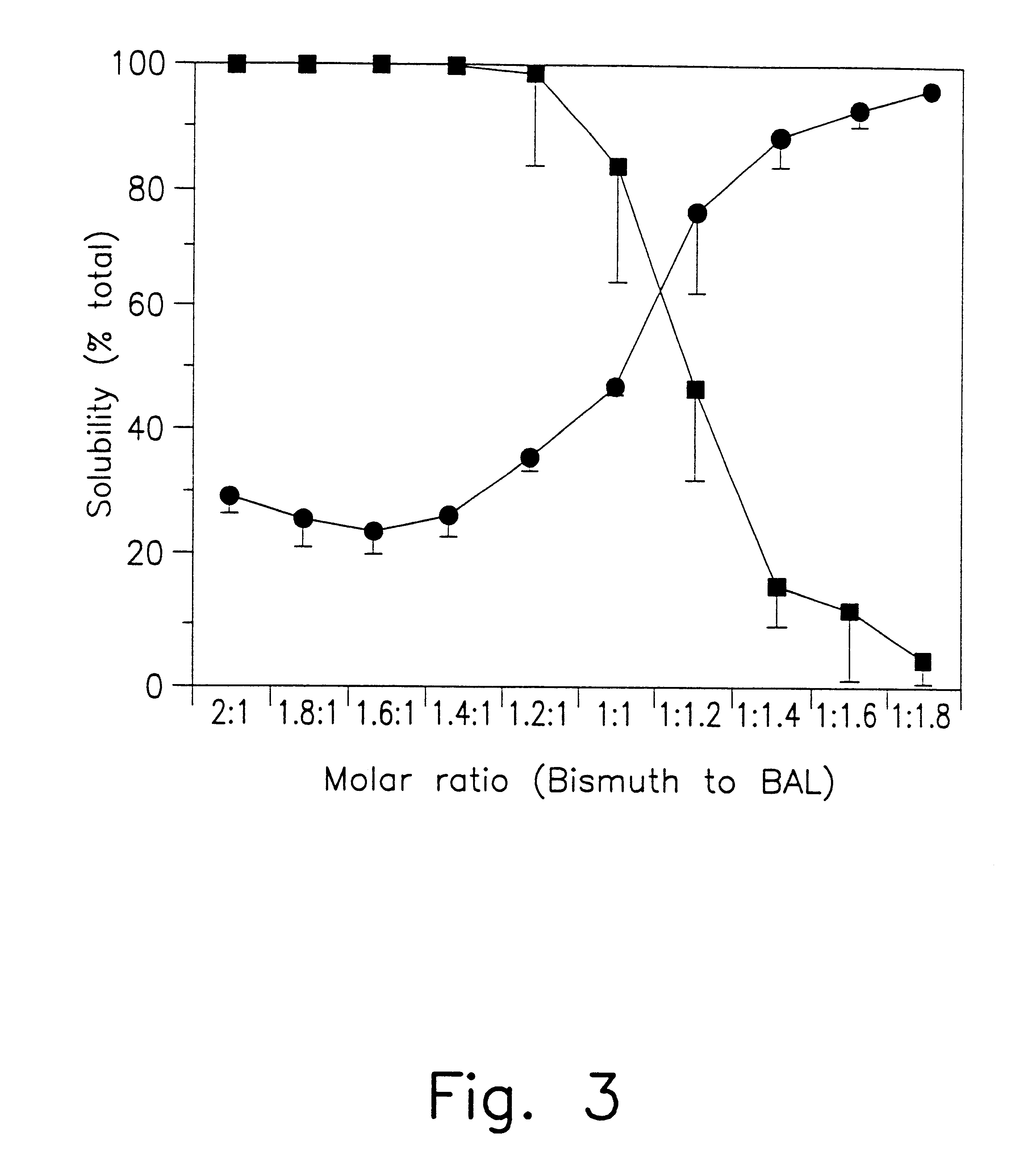Metal/thiol biocides
a technology of metal/thiol and biocides, which is applied in the direction of biocide, antibacterial agents, drug compositions, etc., can solve the problems of diarrhea, e. coli, campylobacter, etc., and the most frequent discomfort of diarrhea
- Summary
- Abstract
- Description
- Claims
- Application Information
AI Technical Summary
Benefits of technology
Problems solved by technology
Method used
Image
Examples
example 2
Antimicrobial Activity of Bismuth:Dimercaprol
Bacteria and Culture Conditions
Nosocomial pathogens were employed to determine the range of bismuth:dimercaprol antimicrobial activity. The following bacteria were cultured in a standard broth medium, e.g., Mueller-Hinton II, overnight: Klebsiella pneumonia O1:K2 strain 52145, Non O1 Vibrio cholerae strain NRT36S, Salmonella enteritidis strain ATCC 14028, Shigella flexneri ATCC 12022, Yersinia enterocolitica ATCC 27729, enterohemorrhagic Escherichia coli 0157:H7 (ATCC 35150), and enterotoxigenic Escherichia coli ATCC 43896. Anaerobes included Clostridium perfringens ATCC 13124 and Bacteroides fragilis ATCC 23745. Ten Pseudomonas aeruginosa strains resistant to aminoglycoside antibiotics were obtained from the Schering-Plough collection. Several clinical isolates of Providencia, Serratia, and Xanthomonas were tested; Proteus strains included P. vulgaris O:19, P. vulgaris ATCC 49990, P. mirabilis ATCC 49995, P. mirabilis ATCC 51286, and P. ...
example 3
Antimicrobial Activity of Several Bis-thiols and Bis-nonthiols
In an effort to enhance activity by increasing solubility, bismuth was combined with several potential chelating agents. The non-thiol compounds tested were D-penicillamine, 2,2'-diaminobutyric acid, spermidine, cis 1,3-dichloropropene, EDDA, 2-Bromo-2-nitro-1,3propanediol, salicylhydroxamic acid, sodium bisulfite, and EDTA. Tested thiols included dimercaprol (bismuth), .beta.-mercaptoethanol (.beta.ME), 2-mercaptoethylamine (MEN), dithiothreitol (DTT), dimercaptopropane-1-sulfonic acid (DMPS), dimercaptosuccinic acid (DMSA), 1-monothioglycerol (MTG), 1,3-propanedithiol, (PDT), 3-mercapto-2-butanol (MBO), 2-mercaptopyrimidine, 2-thiouracil, 1-thio.beta.-D-glucose, thiosalicylic acid, thimerosal, thiolactic acid, meso-1-1'-dimercaptoadipic acid, 2,3-dimercaptopropanol tributyrate, thioglycolic acid, thiostrepton, L-cysteine, reduced glutathione, p-thiocresol, thiodiglycol, 2-mercaptobenzothiazole, pyrithione, thioanisole, ...
example 4
Antiviral Activity of Bismuth:Dimercaprol
Bismuth thiols such as bismuth:ethanedithiol or bismuth:dimercaprol are suggested for viral applications such as herpes. The infectivity titer of adenovirus, echovirus, and respiratory synetial virus was unchanged after 3 h at 37.degree. C. with 50 .mu.M Bi(No.sub.3).sub.3, 25 .mu.M dimercaprol (Bismuth-dimercaprol). However the infectivity of cytomegalovirus, herpes simplex virus type 1 (HSV-1), and HSV-2 decreased 83%, 99.2% and >99.9%, respectively. Neither Bi(NO.sub.3).sub.3 nor dimercaprol alone had an effect. In vivo experiments consisted of topical (25 .mu.l) and oral (100 .mu.l) treatments of hairless mice cutaneously infected with herpes simplex virus 1. Treatments were 3 times / day for 5 days. Lesions were scored 0 to 10 (severe zosteriform ulceration). For topical treatment 8 weeks old mice were used, 10 treated with DMSO and 10 treated with 10 mM Bi(NO.sub.3).sub.3, 5 mM dimercaprol. The control group had a PMLS of 7.5 on day 6 and...
PUM
| Property | Measurement | Unit |
|---|---|---|
| pH | aaaaa | aaaaa |
| pH | aaaaa | aaaaa |
| pH | aaaaa | aaaaa |
Abstract
Description
Claims
Application Information
 Login to View More
Login to View More - R&D
- Intellectual Property
- Life Sciences
- Materials
- Tech Scout
- Unparalleled Data Quality
- Higher Quality Content
- 60% Fewer Hallucinations
Browse by: Latest US Patents, China's latest patents, Technical Efficacy Thesaurus, Application Domain, Technology Topic, Popular Technical Reports.
© 2025 PatSnap. All rights reserved.Legal|Privacy policy|Modern Slavery Act Transparency Statement|Sitemap|About US| Contact US: help@patsnap.com



